New Zealand stretches 1,000 miles from north to south and consists of two
major islands with several smaller islands scattered around them. New
Zealand is roughly 6,000 miles from the US, 1,000 miles south of Fiji, and
1,350 miles east of Australia. The Bay of Islands is located near the
northern part of the North Island.
We departed for Auckland, New Zealand on Friday at 5:40 p.m. from Newark,
New Jersey and arrived by mid-morning on Sunday after crossing the
international date line (we lost a day). The charter company, Chart Link,
met us at the airport and drove us four hours to Opua in the Bay of Islands
where our yachts were waiting. We stowed our gear by mid-afternoon and
sailed a short distance to Russell where we found a quiet, secluded,
beautiful anchorage and enjoyed a relaxing evening. The next morning we
briefly shopped in Russell and then sailed across the bay to Pahia where we
visited an estate and museum. In the mid-afternoon we sailed north in the
Bay of Islands to Marsden Cross where we again found a quiet, secluded,
beautiful anchorage. The next three days were spent exploring the Bay of
Islands after which we rounded Cape Brett and headed south towards Tutukaka.
The first week of sailing took us to remote, unspoiled, uninhabited islands
that were unmatched in beauty and archaeological significance. Tutukaka was
the first signs of civilization with a small harbor where we got fuel and
water and did our laundry. One of our crews dropped off their boat and
headed to the South Island to hike the Milford Track and explore the area
around Queenstown. The remaining two boats continued south towards Auckland
stopping at Great Barrier Island to go jeeping and exploring. On Friday we
arrived in Auckland, debarked the boats, and took a two day road trip to
Rotorua to investigate the Maori culture. We departed for home on Sunday and
arrived just before midnight on Sunday in Newark (gained a day crossing the
international date line). The trip was graded most excellent.
The crew members met at a party prior to our sailing trip and learned
about the skippers' experience and style. Several of the crew members had
already sailed together. After our pre-sail party, each person requested a
boat (skipper). Each skipper requested a crew. The crew got their first
choice and the skippers got their requested crew. There was a good balance
of experience on each boat as well.
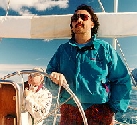 Overall,
we had excellent sailing weather, favorable winds, and no major problems.
Our boats were ready and waiting for us when we arrived, the anchorage's
were all like a little piece of paradise, and the people were amazing
friendly. Below, we describe the sailing experience as recorded in our
journals. When we arrived in Auckland we were met at the airport by Mark
Cressey from Chart Link of Auckland. After the paperwork, we headed north
for four hours to Opua, where they had positioned the boats for our
departure. Mark was very helpful prior to the trip. During the trip he was
very helpful in making arrangements for transportation and accommodations
during our subsequent ground adventure.
Overall,
we had excellent sailing weather, favorable winds, and no major problems.
Our boats were ready and waiting for us when we arrived, the anchorage's
were all like a little piece of paradise, and the people were amazing
friendly. Below, we describe the sailing experience as recorded in our
journals. When we arrived in Auckland we were met at the airport by Mark
Cressey from Chart Link of Auckland. After the paperwork, we headed north
for four hours to Opua, where they had positioned the boats for our
departure. Mark was very helpful prior to the trip. During the trip he was
very helpful in making arrangements for transportation and accommodations
during our subsequent ground adventure.
The Bay of Islands and Waipoua Kauri Forest are an area of great
natural beauty. The Maritime and Historic Park includes 38 different sites
extending from Mimiwhangata Bay in the south to Whangaroa Harbor in the
north. Marked walks range from 10 minutes to 10 hours includes hikes
around islands, historical sites, and the Mimiwhangata Marine Park.
Opua is a quaint, small town with a grocery
conveniently located nearby. After some final provisioning we had our gear
and food securely stowed with a couple hours of sunlight left and we were
interested in a quiet, secluded anchorage. We were ready to get under way
in about an hour and headed north to the town of Russell. We discovered a
small secluded bay complete with beach surrounded by rugged hills and well
protected from the wind. After dinner we all retired a little early as we
had been traveling for over 32 hours after a full day of work. Early the
next morning we headed across the bay to the town dock of Russell where we
explored the town and shops.
Russell is a beautiful little town on the water of a large
island in the southern part of the Bay of Islands. 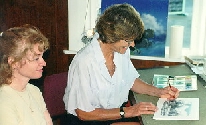 In a word, it is picturesque with
little shops selling bread, art, and antiques. Other little shops provide
the yachtsman with basic provisions.
In a word, it is picturesque with
little shops selling bread, art, and antiques. Other little shops provide
the yachtsman with basic provisions. 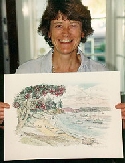 Although the town is a little touristy, it is
not very accessible to there are not large numbers of tourists that visit
the town. We found the town dock very convenient and accessible to the
town center. I got a painting and a photograph of the artist.
Although the town is a little touristy, it is
not very accessible to there are not large numbers of tourists that visit
the town. We found the town dock very convenient and accessible to the
town center. I got a painting and a photograph of the artist. 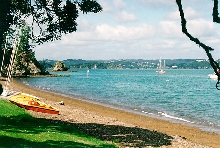 As we walked
back to our boats we passed the beach by the town front that looked
identical to the paintings that we had just bought. We spent a moments in
the tranquil setting pondering the significance of the world's problems
and then moved on. In the early afternoon we departed for Paihia where we
would visit the estate and museum.
As we walked
back to our boats we passed the beach by the town front that looked
identical to the paintings that we had just bought. We spent a moments in
the tranquil setting pondering the significance of the world's problems
and then moved on. In the early afternoon we departed for Paihia where we
would visit the estate and museum.
Paihia is the main town and was settled by Europeans as a
mission station in 1823. The missionary zeal has been replaced with
excellent shops, accommodations, and entertainment. It's a happening
place. Waitangi National Reserve was built in 1832 as the
home of British Resident James Busby and was the location for the historic
signing of the Treaty of Waitangi (eight years later Maori chiefs accepted
British sovereignty). The estate is beautiful with a lawn running down to
the bay. A road climbs to Mt. Bledisloe with panoramic views of the bay
and easy access to mangrove forests and awesome water falls. The entrance
to the harbor is quite shallow so we anchored off-shore and dinghied in. Haruru
Falls are very attractive and photogenic. They are easily
accessible via the walkway through the Waitangi National Reserve. At the
foot of the falls is good swimming. The round-trip hike was estimated to
be a couple hours which was more than we had time if we wanted to make our
afternoon sail. So, we skipped the falls and departed in the late
afternoon for Marsden Cross.
The winds in the mid afternoon were five to ten knots from the
northeast. We were able to sail for a good part of the way to our evening
destination which was only a few miles. We were crossing the Bay of
Islands to the northern shore where we would find a small cove sheltered
by the wind by some tall mountains and protected by the sea swells which
were slight. We anchored in about sixteen feet of water with plenty of
room to swing in case the wind shifted. The bottom was sand and mud with
some rocks near shore. We had dinner on board as there was no civilization
ashore.
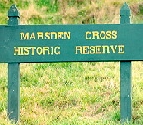 Marsden
Cross... Early in the morning we went to shore for a hike. We first
came upon Marsden Cross and some small commemorative plaques.
Marsden
Cross... Early in the morning we went to shore for a hike. We first
came upon Marsden Cross and some small commemorative plaques. 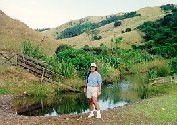 There was a dirt
road that lead up the valley to the north with rolling hills on either
side. Our hike took us past some cows grazing in the fields and to a ridge
that overlooked the bay in which we were anchored. The panoramic views of
the Bay of Islands to the south were most beautiful.
There was a dirt
road that lead up the valley to the north with rolling hills on either
side. Our hike took us past some cows grazing in the fields and to a ridge
that overlooked the bay in which we were anchored. The panoramic views of
the Bay of Islands to the south were most beautiful. 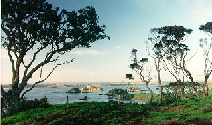 We continued
hiking along the ridge back towards our yachts. It was a most pleasant
early morning hike. We returned to our boats for breakfast and a leisurely
sail south to the beautiful island of Motuarohia.
We continued
hiking along the ridge back towards our yachts. It was a most pleasant
early morning hike. We returned to our boats for breakfast and a leisurely
sail south to the beautiful island of Motuarohia. 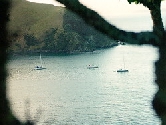 The winds started at about fifteen
knots and the seas were slight. We only needed to make a few tacks on our
way and the winds increased to eighteen to twenty knots. Our speed was
about seven knots and the sail was about an hour and a half. Our anchorage
was protected from the wind and the bottom was good holding in sand. Lots
of photo opportunities.
The winds started at about fifteen
knots and the seas were slight. We only needed to make a few tacks on our
way and the winds increased to eighteen to twenty knots. Our speed was
about seven knots and the sail was about an hour and a half. Our anchorage
was protected from the wind and the bottom was good holding in sand. Lots
of photo opportunities. 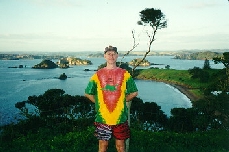 Atop the highes hill we chose to make a fashion statement
with bright colored clothes imported from the British Virgin Islands. From
our vantage point we could quickly spot any native not conforming to our
strict dress code and provide the appropriate disciplinary action. We
found an abundance of color coordinated cows and other livestock that
greatly appreciated our tireless efforts. The natives often stared with
envy as our entourage travelled by.
Atop the highes hill we chose to make a fashion statement
with bright colored clothes imported from the British Virgin Islands. From
our vantage point we could quickly spot any native not conforming to our
strict dress code and provide the appropriate disciplinary action. We
found an abundance of color coordinated cows and other livestock that
greatly appreciated our tireless efforts. The natives often stared with
envy as our entourage travelled by.
Motuarohia Island... Our next destination was just a lunch stop.
The anchorage was in a bay the shape of a half moon surrounded by a
beautiful white sand beach. 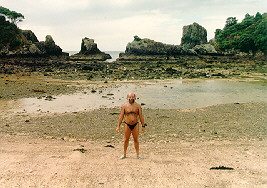 There were a couple other boats in the anchorage
but otherwise secluded. We had a leisurly lunch and then dinghied to shore
and was met by the guardian of the island demanding that we return to our
ships at once. He was a nimble warrier armed only with a Cassio watch and
reef shoes. My crew retreated at once for fear of their lives while I
advanced slowly. Noting that I, too, had a Casio watch we
There were a couple other boats in the anchorage
but otherwise secluded. We had a leisurly lunch and then dinghied to shore
and was met by the guardian of the island demanding that we return to our
ships at once. He was a nimble warrier armed only with a Cassio watch and
reef shoes. My crew retreated at once for fear of their lives while I
advanced slowly. Noting that I, too, had a Casio watch we 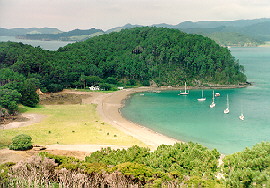 immediately
became friends and he gave us all a tour of the island. We climbed to the
top of a hill with extraordinary views of the Bay of Islands in all
directions and a great view of our boats in the anchorage. The weather was
very clear and the visibility was perhaps thirty miles. We only saw one
estate on the island perched on a cliff with an amazing view of the rocky
shore. Opposite, was our anchorage framed by the beach and wooded shore on
either side. Though we wanted to stay, we had more beaches to see and
islands to explore. Next, we sailed to Moturua Island.
immediately
became friends and he gave us all a tour of the island. We climbed to the
top of a hill with extraordinary views of the Bay of Islands in all
directions and a great view of our boats in the anchorage. The weather was
very clear and the visibility was perhaps thirty miles. We only saw one
estate on the island perched on a cliff with an amazing view of the rocky
shore. Opposite, was our anchorage framed by the beach and wooded shore on
either side. Though we wanted to stay, we had more beaches to see and
islands to explore. Next, we sailed to Moturua Island.
We then sailed to Moturua Island to the east where we tried to anchor
in hard mud and rock. Only one boat was successful in getting a good set
so we all decided to go around the corner to a cove with a white sand
beach surrounded by tall hills. It was better protected form the wind and
very picturesque. The seas were slight and the anchorage very comfortable.
Early the next morning we went to shore and hiked the route described in
the guide. We next set sail for Motuarohia Island which also turned out to
be another piece of paradise, well protected, and sheltered from the wind.
Moturua Island... Like many of the islands in the
Bay of Islands, Moturua Island is one of great archeological significance
in addition to most excellent beaches, anchorages, and hiking trails. Our
first challenge was to get the group to shore. The dinghies were small
though our crews brave. 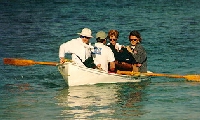
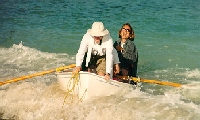
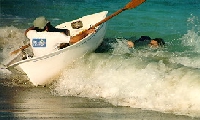 Our group was dinghied to shore a few at a time.
Luckily, the distance to travel from the boats to shore was short and it
was not long before our group was assembled on the beach.
Our group was dinghied to shore a few at a time.
Luckily, the distance to travel from the boats to shore was short and it
was not long before our group was assembled on the beach. 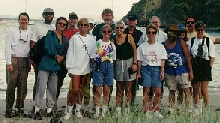
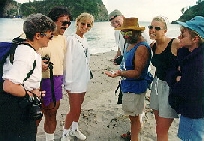 Once ashore, we
found Dr. Science who was quick to discover ancient artifacts along
the beach and describe its origin and significance to the evolution of the
native culture. Moturua is now being left to regenerate to native bush and
in the moist valleys regeneration is happening quite rapidly. Young
pohutukawas abound all along the coast and are particularly prevalent on
the track up to Hikurangi Pa.
Once ashore, we
found Dr. Science who was quick to discover ancient artifacts along
the beach and describe its origin and significance to the evolution of the
native culture. Moturua is now being left to regenerate to native bush and
in the moist valleys regeneration is happening quite rapidly. Young
pohutukawas abound all along the coast and are particularly prevalent on
the track up to Hikurangi Pa. 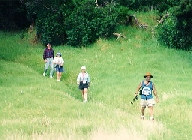 Birdlife on the island is varied and moreporks
can often be seen. Kiwis have been liberated by the park and thrive in the
bush of Moturua. We set out on a hike along the trails noting that they
were not well travelled by our standards though likely to be considered a
busy tourist attraction by the locals.
Birdlife on the island is varied and moreporks
can often be seen. Kiwis have been liberated by the park and thrive in the
bush of Moturua. We set out on a hike along the trails noting that they
were not well travelled by our standards though likely to be considered a
busy tourist attraction by the locals. 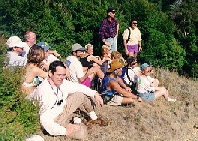 We found that the island was
unspoiled and very beautiful. Our hike took us all the way around the
island, up hills, down hills, along the beaches and rocky shoreline.
We found that the island was
unspoiled and very beautiful. Our hike took us all the way around the
island, up hills, down hills, along the beaches and rocky shoreline. 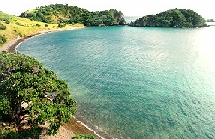 Moturua is the
second largest in the Bay of Island and has provided fresh water and
shelter to early travellers. The walking track takes about two hours to
complete and passes four of the island's sandy beaches and there are
panoramic views of the bay.
Moturua is the
second largest in the Bay of Island and has provided fresh water and
shelter to early travellers. The walking track takes about two hours to
complete and passes four of the island's sandy beaches and there are
panoramic views of the bay. 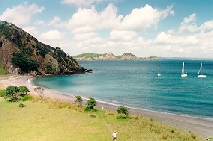 The island is part of the national park system
called scenic reserves. These reserves have preserved the archaeology from
the early settlers and have provided few placards describing the sites.
The natives would build a "pa" which referred to any major Maori
settlement though is used in archaeology to refer to any fortified site.
These sites included primitive types of defense such as installing ditches
across main access routes; building on a hilltop and making steep terraces
around the slopes; building steep ridges (like a wall) around the village;
and, combinations of these techniques. building upon a hill or ridge
The island is part of the national park system
called scenic reserves. These reserves have preserved the archaeology from
the early settlers and have provided few placards describing the sites.
The natives would build a "pa" which referred to any major Maori
settlement though is used in archaeology to refer to any fortified site.
These sites included primitive types of defense such as installing ditches
across main access routes; building on a hilltop and making steep terraces
around the slopes; building steep ridges (like a wall) around the village;
and, combinations of these techniques. building upon a hill or ridge
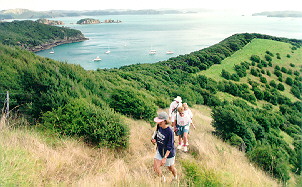 Urupukapuka
Island was difficult to pronounce at first but soon rolled off our
tongues like like we were native. There are many sandy beaches with clear
water. The diving on the east coast is particularly good since there is a
lot of reef life. There are many secluded bays that are perfect for
picnics. The archaeological features of the island are interesting because
of the diversity of sites and their good state of preservation.
Urupukapuka
Island was difficult to pronounce at first but soon rolled off our
tongues like like we were native. There are many sandy beaches with clear
water. The diving on the east coast is particularly good since there is a
lot of reef life. There are many secluded bays that are perfect for
picnics. The archaeological features of the island are interesting because
of the diversity of sites and their good state of preservation. 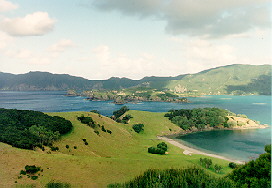 There are trails
with on-site signs that describe many of the pre-European sites. The whole
walk takes about five hours though it can be divided in half. There is a
pamphlet that describes the island sites. We found that the trails were
easy to follow over the rolling hills. The views of the bay of islands
were spectacular as this island (I was trying to avoid spelling "Urupukapuka")
is centrally located. The anchorage was nestled between the hills and well
protected from the wind and sea. The hiking was an excellent workout.
There are trails
with on-site signs that describe many of the pre-European sites. The whole
walk takes about five hours though it can be divided in half. There is a
pamphlet that describes the island sites. We found that the trails were
easy to follow over the rolling hills. The views of the bay of islands
were spectacular as this island (I was trying to avoid spelling "Urupukapuka")
is centrally located. The anchorage was nestled between the hills and well
protected from the wind and sea. The hiking was an excellent workout.
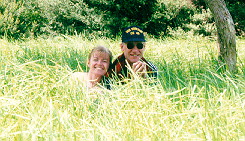 Whangamumu
Bay is a place of peace and serenity. It is a combination of scenic
beauty and gentle reminders of days past. During out visit we were able to
observe two pre-historic Maori natives dressed as modern-day sailors
hiding in the grass. The nearby native bush includes tanekaha, cabbage
trees and nikau palms. The bay is excellent for swimming. The site is of
historical value, notable for its two large pas on the ridgeline south of
the harbour. At the whaling station the remains of vats, a boiler and two
concrete slipways are still visible. Whangamumu was famous for the
extensive whaling operations as they hunted humpback whales.
Whangamumu
Bay is a place of peace and serenity. It is a combination of scenic
beauty and gentle reminders of days past. During out visit we were able to
observe two pre-historic Maori natives dressed as modern-day sailors
hiding in the grass. The nearby native bush includes tanekaha, cabbage
trees and nikau palms. The bay is excellent for swimming. The site is of
historical value, notable for its two large pas on the ridgeline south of
the harbour. At the whaling station the remains of vats, a boiler and two
concrete slipways are still visible. Whangamumu was famous for the
extensive whaling operations as they hunted humpback whales.
Mimiwhangata Bay contains some of the most attractive coastline
of eastern Northland. Its offshore islands, rocky headlands, sandy
beaches, coastal dunes and pohutukawa-studded cliffs are enhanced inland
from the coastal strip of dozens of archaeological sties, large tracts of
native bush containing kiwis, farmland, streams and wetlands with
increasing numbers of the rare brown teal. There are several islands and
reefs that surround the Mimiwhangata peninsula. The coas5tlie is rich in
marine life, and provides a wide range of dexcllent diving opportunities,
as well as interesting rocky shores to explore.
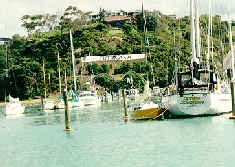 Tutukaka
is a small fishing town that hosts an annual tornament during the second
week of March - the time that we arrived.
Tutukaka
is a small fishing town that hosts an annual tornament during the second
week of March - the time that we arrived. 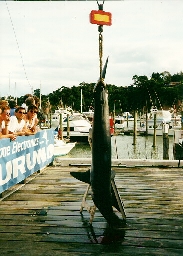 All the boat slips were reserved
and we were only able to spend a few hours at dock. We were able to get
fuel and water and wash our clothes after a week of sailing. It was the
first place that we came to where there were facilities, restaurants, and
grocery stores. We took real showers. Cool! In the late afternoon we moved
our yachts to the anchorage and returned by dinghy and a borrowed car to
the dock where we observed the fishing boats come back from their day at
sea. Many large fish were brought to dock and weighed. Meanwhile, We had a
most excellent dinner at the marina restaurant and enjoyed a peaceful and
relaxing evening.
All the boat slips were reserved
and we were only able to spend a few hours at dock. We were able to get
fuel and water and wash our clothes after a week of sailing. It was the
first place that we came to where there were facilities, restaurants, and
grocery stores. We took real showers. Cool! In the late afternoon we moved
our yachts to the anchorage and returned by dinghy and a borrowed car to
the dock where we observed the fishing boats come back from their day at
sea. Many large fish were brought to dock and weighed. Meanwhile, We had a
most excellent dinner at the marina restaurant and enjoyed a peaceful and
relaxing evening.
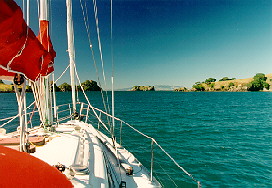 Great
Barrier Island is about 56 miles from the mainland and is the largest
island in the Hauraki Gulf. The most popular activities include hiking,
swimming, boating, and fishing. There are only 1000 inhabitants on the
island with 110 square miles and plenty of open space. Just a few miles to
the west of the entrace to Port Fitzroy we encountered a large school of
dolphin.
Great
Barrier Island is about 56 miles from the mainland and is the largest
island in the Hauraki Gulf. The most popular activities include hiking,
swimming, boating, and fishing. There are only 1000 inhabitants on the
island with 110 square miles and plenty of open space. Just a few miles to
the west of the entrace to Port Fitzroy we encountered a large school of
dolphin. 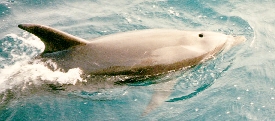 They were headed north while we were headed east. A few of the dolphin
would play in our bow wave and occasionally bump up against the bow. They
would travel in small groups and often swim in unison. They practiced
synchronized jumping out of the water the way dolphins do in the movies.
They were headed north while we were headed east. A few of the dolphin
would play in our bow wave and occasionally bump up against the bow. They
would travel in small groups and often swim in unison. They practiced
synchronized jumping out of the water the way dolphins do in the movies. 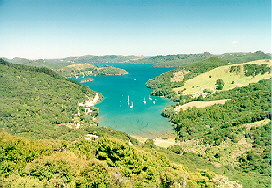 Port Fitzroy
was our second choice for an anchorage as we tried to find a good spot in
the next bay over but had difficulty. Fitzroy was a quiet, beautiful
harbor with limited facilities. It is well protected from winds and seas
from all directions except from the west. The wind that night was from the
west and it exceeded 35 knots at times.
Port Fitzroy
was our second choice for an anchorage as we tried to find a good spot in
the next bay over but had difficulty. Fitzroy was a quiet, beautiful
harbor with limited facilities. It is well protected from winds and seas
from all directions except from the west. The wind that night was from the
west and it exceeded 35 knots at times. 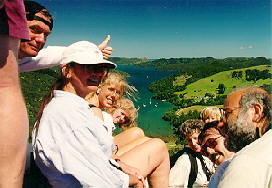 The next day we went for a morning
hike up the nearby mountain and discovered most excellent views of our
yachts. The hike was less than an hour and the trail was well travelled.
The weather was pleasant and the visibility was unlimited. As we looked
inland we saw many taller mountains and wish we only had time for longer
hikes. Hiking on the island is very popular among world travelers.
The next day we went for a morning
hike up the nearby mountain and discovered most excellent views of our
yachts. The hike was less than an hour and the trail was well travelled.
The weather was pleasant and the visibility was unlimited. As we looked
inland we saw many taller mountains and wish we only had time for longer
hikes. Hiking on the island is very popular among world travelers. 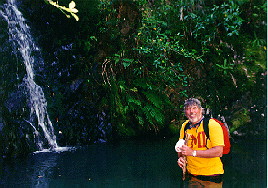 The hike down
was easy and our next destination was the waterfalls which was a half hour
by road and then another half hour on the trail. Again, we found the trail
to be well travelled and quite scenic. When we arrived at the falls we
found an artist painting a young lady (not painting her but a portrait of
her). Tom went wading while doug went for a swim. The water was cool.
The hike down
was easy and our next destination was the waterfalls which was a half hour
by road and then another half hour on the trail. Again, we found the trail
to be well travelled and quite scenic. When we arrived at the falls we
found an artist painting a young lady (not painting her but a portrait of
her). Tom went wading while doug went for a swim. The water was cool. 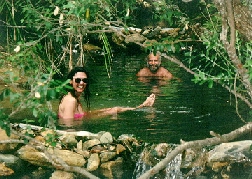 The next day
several people went for a hike to the hot springs. The trail was a bit
muddy though it was well travelled. Many of the island have hot springs
because of the amount of geothermal activity. Most of the hot springs are
off the beaten trail and require hiking between a half hour and two hours.
It is well worth the hike because the trails are excellent and the springs
are fun and relaxing. One day we found a stingray swimming in the water
near the dock.
The next day
several people went for a hike to the hot springs. The trail was a bit
muddy though it was well travelled. Many of the island have hot springs
because of the amount of geothermal activity. Most of the hot springs are
off the beaten trail and require hiking between a half hour and two hours.
It is well worth the hike because the trails are excellent and the springs
are fun and relaxing. One day we found a stingray swimming in the water
near the dock. 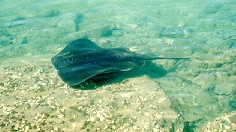 The dockmaster said that the stingray had been seen there
often and apparently comes there to feed. We observed it swimming in very
shallow water. It's diameter was about three feet. We have often seen
stingrays in the Caribbean but this was the first time we spotted one in
the South Pacific.
The dockmaster said that the stingray had been seen there
often and apparently comes there to feed. We observed it swimming in very
shallow water. It's diameter was about three feet. We have often seen
stingrays in the Caribbean but this was the first time we spotted one in
the South Pacific.
 Rotorua
(central North Island) is famous for thermal activity (boiling water,
hissing steam, bubbling mud pools) and the Maori culture (night-time Maori
concerts and a Hangi). Nearby Waitomo Caves, on the way to Rotorua,
are limestone caverns with stalactites and stalagmites and a glow-worm
grotto. Black Water Rafting is a particular thrill. The Tongario
National Park has some of the best mountain/volcano scenery in the
country and excellent hiking trails.
Rotorua
(central North Island) is famous for thermal activity (boiling water,
hissing steam, bubbling mud pools) and the Maori culture (night-time Maori
concerts and a Hangi). Nearby Waitomo Caves, on the way to Rotorua,
are limestone caverns with stalactites and stalagmites and a glow-worm
grotto. Black Water Rafting is a particular thrill. The Tongario
National Park has some of the best mountain/volcano scenery in the
country and excellent hiking trails. 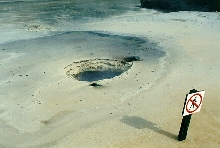 We returned the boats on Friday morning leaving
almost two days to tour the northern island by road. We rented a very
large passenger van and drove from Auckland to Rotorua. Our first stop was
the Marriott where there was a native show. It was well done and worth the
time and money. Early the next day (okay, late morning) we went on our own
to explore the geothermal activity.
We returned the boats on Friday morning leaving
almost two days to tour the northern island by road. We rented a very
large passenger van and drove from Auckland to Rotorua. Our first stop was
the Marriott where there was a native show. It was well done and worth the
time and money. Early the next day (okay, late morning) we went on our own
to explore the geothermal activity. 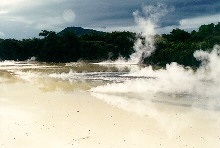 It is important not to wander off the marked
trails because the ground will not necessarily support the weight of a
human. Many vent holes and hot springs are scattered throughout the area.
The hotels have brochures and are helpful in recommending a geothermic
location based on the amount of walking that you are interested in doing.
It is important not to wander off the marked
trails because the ground will not necessarily support the weight of a
human. Many vent holes and hot springs are scattered throughout the area.
The hotels have brochures and are helpful in recommending a geothermic
location based on the amount of walking that you are interested in doing. 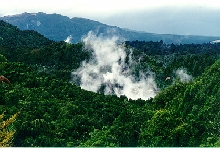 We found that
within 45 minutes walk there was a good amount of geothermal activity to
be seen. While hiking along the paths at the geothermal tourist areas the
vents in the nearby valleys would spew forth steam and sulpher gas. The
whole town and country side smelled like sulpher and was quite unpleasant
at first though the odor became less intense with beer and other alcoholic
beverages.
We found that
within 45 minutes walk there was a good amount of geothermal activity to
be seen. While hiking along the paths at the geothermal tourist areas the
vents in the nearby valleys would spew forth steam and sulpher gas. The
whole town and country side smelled like sulpher and was quite unpleasant
at first though the odor became less intense with beer and other alcoholic
beverages.
Queenstown (South Island) is a resort town with genteel boat
trips on the lake, visits to sheep stations, shooting rapids upstream in
jet-boats or downstream in inflatables, and excellent walking trips. Jet
boating has become tremendously popular on the Shotover and Kawarau
rivers. Queenstown is a paradise for adventure seekers. The South Island
Alps rise steeply, almost from sea level and the Mount Cook National Park
contains all but five of the twenty-seven peaks in New Zealand over 9,750
feet tall.
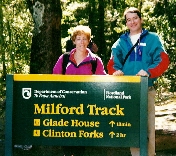 The Milford
Track is considered one of the "finest walks in the world."
It is unique to New Zealand. The highlights include beautiful views from
the Mackinnon Pass, the 630 meter Sutherland Falls, the rain forest, and
crystal clear streams full of fat trout. The hike can only be done in one
direction, from Lake Te Anau to Milford. A park permit is required and
must be booked as far as a year in advance.
The Milford
Track is considered one of the "finest walks in the world."
It is unique to New Zealand. The highlights include beautiful views from
the Mackinnon Pass, the 630 meter Sutherland Falls, the rain forest, and
crystal clear streams full of fat trout. The hike can only be done in one
direction, from Lake Te Anau to Milford. A park permit is required and
must be booked as far as a year in advance. 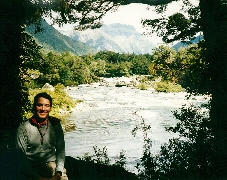 It is a four day hike with huts
along the way so all you carry is your personal gear. The $600 cost
includes a boat ride, hotel stays at the beginning and end of the hike,
comfortable sleeping accommodations with food prepared each night.
Approximate hiking distance each day is about ten miles. Other hikes are
also available options.
It is a four day hike with huts
along the way so all you carry is your personal gear. The $600 cost
includes a boat ride, hotel stays at the beginning and end of the hike,
comfortable sleeping accommodations with food prepared each night.
Approximate hiking distance each day is about ten miles. Other hikes are
also available options. 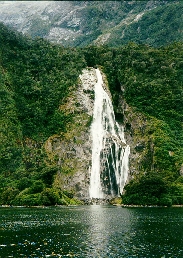
Parties of about 40 people leave Te Anau several times weekly during
the season (November to April). Accommodation while on the trek is in
staffed lodges with comfortable bunkrooms. The trek is divided into
sectors, varying from 10 to 15 miles. On leaving the lodge in the morning,
trekkers set their own pace, usually travelling in small groups. One guide
follows and another awaits the party at the lunch stop. Some trekkers will
complete the day's stage by early afternoon; those preferring a more
leisurely passage arrive several hours later. After dinner there is a shor
tbriefing session with the remainder of the evening being free for social
activities.
From our journal...
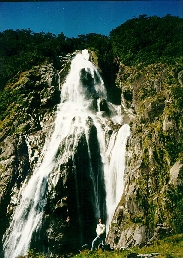 Tuesday
12 March: Milford Track depart at 7:45 am from
Queenstown. Fly to Te Anau and check in at the Milford Track Office. Take
group photo. Ride coach to Te Anau Downs and board a launch - cruise to
Glade House at the head of Lake Te Anau. The Milford Track starts here. Wednesday
13 March: Beautiful scenery. Lots of birds and wildlife. The guides
are very knowledgable about the history, geography, and wildlife. After
leaving Glade House, we crossed the Clinton River and walked through
beautiful beech forests before lunch at Hirere Falls. From the grassy
plain known as the Prairie, there is a spectacular view of Clinton Canyon
and the Mackinnon Pass. It's a rocky climb to Marlenes Creek and onto
Pompolona Lodge for a hot shower and a hearty meal.
Tuesday
12 March: Milford Track depart at 7:45 am from
Queenstown. Fly to Te Anau and check in at the Milford Track Office. Take
group photo. Ride coach to Te Anau Downs and board a launch - cruise to
Glade House at the head of Lake Te Anau. The Milford Track starts here. Wednesday
13 March: Beautiful scenery. Lots of birds and wildlife. The guides
are very knowledgable about the history, geography, and wildlife. After
leaving Glade House, we crossed the Clinton River and walked through
beautiful beech forests before lunch at Hirere Falls. From the grassy
plain known as the Prairie, there is a spectacular view of Clinton Canyon
and the Mackinnon Pass. It's a rocky climb to Marlenes Creek and onto
Pompolona Lodge for a hot shower and a hearty meal. 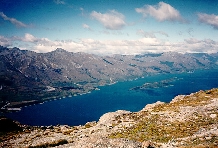 Thursday 14 March: The
views today are awesome ... the St. Quintin Falls, Avalanche Creek, Mirror
Lake and Lake Mintaro. The Mackinnon Pass is reached by a series of long
zigzags. The scenery just keeps on coming: Mount Balloon, the sheer
Jervois Glacier, Roaring Burn, Morraine Creek and the Arthur Valley rain
forest. From the Quintin Hut, it's just a short hop to the Sutherland
Falls.
Thursday 14 March: The
views today are awesome ... the St. Quintin Falls, Avalanche Creek, Mirror
Lake and Lake Mintaro. The Mackinnon Pass is reached by a series of long
zigzags. The scenery just keeps on coming: Mount Balloon, the sheer
Jervois Glacier, Roaring Burn, Morraine Creek and the Arthur Valley rain
forest. From the Quintin Hut, it's just a short hop to the Sutherland
Falls. 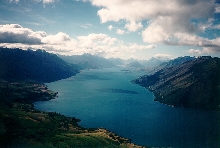 Friday
15 March: It's mostly downhill from here. The view of Bell Rock,
Mackay Falls, the dramatic Giant's Gate Waterfall and Lake Ada was as
awesome as they said. From Sandfly Point, we took a short boat ride to the
Milford Sound Hotel and had a final gathering and party.
Friday
15 March: It's mostly downhill from here. The view of Bell Rock,
Mackay Falls, the dramatic Giant's Gate Waterfall and Lake Ada was as
awesome as they said. From Sandfly Point, we took a short boat ride to the
Milford Sound Hotel and had a final gathering and party. 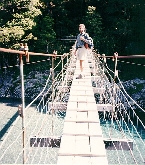 Saturday 16
March: Today was easy - we had a Red Boat cruise on Milford Sound. We
saw Lady Bowen Falls beneath towering Mitre Peak which rises sheer from
the sea.
Saturday 16
March: Today was easy - we had a Red Boat cruise on Milford Sound. We
saw Lady Bowen Falls beneath towering Mitre Peak which rises sheer from
the sea.
We now departed for Queenstown arriving at 12 noon and the airport at
1:00 pm. Departed on Air New Zealand for Rotorua but was diverted because
of weather. They provided a bus ride to Rotorua, arrived an hour and a
half late, and met up with the rest of our group.
Other Activities
We had time for bungi jumping and a helicopter ride to sight see and
briefly visit the top of a glacier.
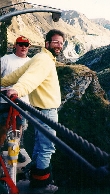 Bungi
Jumping... Was first performed by Tony and then a week later by Anton.
Bungi
Jumping... Was first performed by Tony and then a week later by Anton.
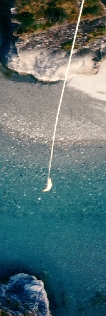 On a bridge,
360 feet above the water that is only a few feet deep, the bungi masters
first clips in and then secures a harness around the feet of the fool that
wants an ultimate rush. Next, the fool jumps off and the bungi masters
watch and score the various aspects of the jump. Some people are scared
silly, but Tony was brave because his wife, Katy, was video taping it for
all to see later at our picture party.
On a bridge,
360 feet above the water that is only a few feet deep, the bungi masters
first clips in and then secures a harness around the feet of the fool that
wants an ultimate rush. Next, the fool jumps off and the bungi masters
watch and score the various aspects of the jump. Some people are scared
silly, but Tony was brave because his wife, Katy, was video taping it for
all to see later at our picture party.
Jet Boat Ride... The Jet Boats are shallow draft vessels whose
engine shoots a stream of highly compressed water out the rear thus
propelling it forward.
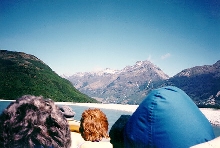
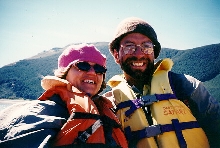
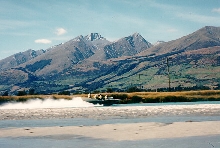
Speeds in excess of 40 mph up narrow, windy rivers with spectacular
scenery in remote areas of the South Island were experienced by four of
our adventurers.
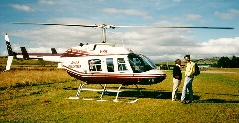 Helicopter...
Helicopter...
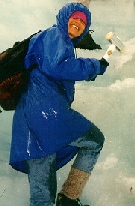
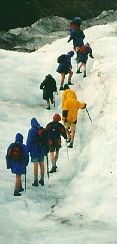
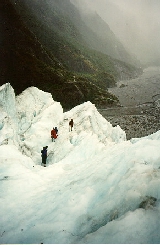
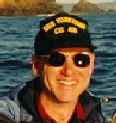 John
Beck is an avid sailor and sailing instructor with the American
Sailing Association (in addition to a "day" job). Throughout the
year he leads several sailing flotillas and instructional workshops
throughout the world. He takes great pride in the unique sailing
adventures as they set the standard for the Club's awesome and incredible
theme with a very high degree of satisfaction. John is also an
accomplished pilot, skier, biker, hiker, and all around adventure junkie.
John
Beck is an avid sailor and sailing instructor with the American
Sailing Association (in addition to a "day" job). Throughout the
year he leads several sailing flotillas and instructional workshops
throughout the world. He takes great pride in the unique sailing
adventures as they set the standard for the Club's awesome and incredible
theme with a very high degree of satisfaction. John is also an
accomplished pilot, skier, biker, hiker, and all around adventure junkie.
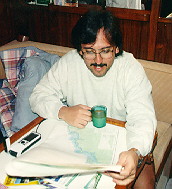 Nabi
Rafie was (and is) very enthusiastic about sailing. Although he
recently became a sailor, he has a natural aptitude and is very skilled at
working all the positions on deck. He is an excellent helms person and has
taken to navigation with accurate, clear charting throughout our trip.
Nabi sets the standard for consideration and adeptness - he was enjoyable
to share a yacht and an excellent cook. He is a pleasure to have aboard.
Already, we are making plans to sail New Zealand and other world-class
cruising areas.
Nabi
Rafie was (and is) very enthusiastic about sailing. Although he
recently became a sailor, he has a natural aptitude and is very skilled at
working all the positions on deck. He is an excellent helms person and has
taken to navigation with accurate, clear charting throughout our trip.
Nabi sets the standard for consideration and adeptness - he was enjoyable
to share a yacht and an excellent cook. He is a pleasure to have aboard.
Already, we are making plans to sail New Zealand and other world-class
cruising areas.
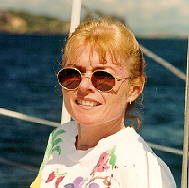 Cathy
Lavelle first boarded a boat and also first experienced the South
Pacific islands on this trip. She was amazed at the beauty of the islands,
the comfort aboard the boat, and the company of the other crew members.
She immediately made friends with everyone and helped make life aboard a
special experience. Cathy is looking forward to learning more about
sailing and exploring the world from the sea.
Cathy
Lavelle first boarded a boat and also first experienced the South
Pacific islands on this trip. She was amazed at the beauty of the islands,
the comfort aboard the boat, and the company of the other crew members.
She immediately made friends with everyone and helped make life aboard a
special experience. Cathy is looking forward to learning more about
sailing and exploring the world from the sea.
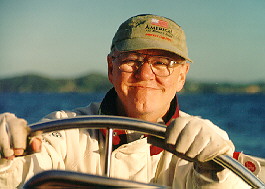 Dick
Machol is an enthusiastic sailor with one week of sailing lessons in
the Caribbean and now two additional weeks in New Zealand. He has a
passion for exploring new places from the sea and enjoys sharing a brief
"life at sea" with his two daughters. As an executive in real
life, Dick enjoys the organized and quality experience while he looks
forward to learning so he can someday give orders (he'd be good at this).
The combination of travel, discovery, and learning gives him pleasure.
Dick's next focus will be on learning navigation.
Dick
Machol is an enthusiastic sailor with one week of sailing lessons in
the Caribbean and now two additional weeks in New Zealand. He has a
passion for exploring new places from the sea and enjoys sharing a brief
"life at sea" with his two daughters. As an executive in real
life, Dick enjoys the organized and quality experience while he looks
forward to learning so he can someday give orders (he'd be good at this).
The combination of travel, discovery, and learning gives him pleasure.
Dick's next focus will be on learning navigation.
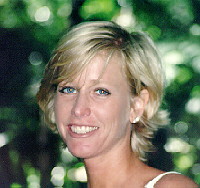 Karen
Machol is a natural sailor with a unique ability to perform almost any
task after a brief introduction. After one week sailing lessons, she
eagerly participating in all aspects of sailing, including steering,
working the sails, and anchoring. Karen was impressed by the natural
beauty of the untouched islands, hiking on uninhabited islands, and
exploring the remote islands, beaches, and forests.
Karen
Machol is a natural sailor with a unique ability to perform almost any
task after a brief introduction. After one week sailing lessons, she
eagerly participating in all aspects of sailing, including steering,
working the sails, and anchoring. Karen was impressed by the natural
beauty of the untouched islands, hiking on uninhabited islands, and
exploring the remote islands, beaches, and forests.
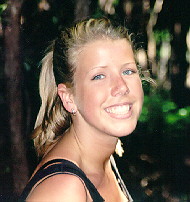 Kathleen
Machol is a most charming person who enjoys sailing and exploring. Her
greatest asset is a unique culinary skill that wins friends worldwide and
makes her welcome on every sailing trip. She enjoys the total experience
along with the evening social, party, and dancing opportunities.
Kathleen
Machol is a most charming person who enjoys sailing and exploring. Her
greatest asset is a unique culinary skill that wins friends worldwide and
makes her welcome on every sailing trip. She enjoys the total experience
along with the evening social, party, and dancing opportunities.
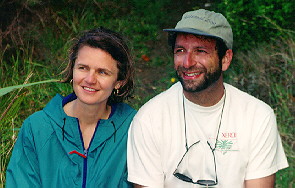 Tony
Frissora joined our Thanksgiving sail four years ago and met his wife
Katy during the voyage. The next year, Tony skippered one of our boats and
during Thanksgiving dinner in some God forgotten islands he proposed to Katy
Badt. They married a year later and continue to skipper during our
Thanksgiving sails. Tony is a very talented sailor and enjoys racing in
the summers in New Jersey. Both Katy and Tony work for AT&T and love
the sea. They both have become good friends and traveling companions to
many of the people who joined his boat this year. Both Tony and Katy do an
excellent job organizing their boat activities and everyone always has a
good time when aboard. Katy has been sailing with the Club for as long as
the Club has been sailing big yachts. She is always helpful with
organizing for the whole group and providing input and feedback to the
planning and operation of the flotillas.
Tony
Frissora joined our Thanksgiving sail four years ago and met his wife
Katy during the voyage. The next year, Tony skippered one of our boats and
during Thanksgiving dinner in some God forgotten islands he proposed to Katy
Badt. They married a year later and continue to skipper during our
Thanksgiving sails. Tony is a very talented sailor and enjoys racing in
the summers in New Jersey. Both Katy and Tony work for AT&T and love
the sea. They both have become good friends and traveling companions to
many of the people who joined his boat this year. Both Tony and Katy do an
excellent job organizing their boat activities and everyone always has a
good time when aboard. Katy has been sailing with the Club for as long as
the Club has been sailing big yachts. She is always helpful with
organizing for the whole group and providing input and feedback to the
planning and operation of the flotillas.
 Mary
Sclafani likes to experience a variety of adventures and has joined
several other sailing trips in the Caribbean and Greek Islands. She is the
perfect explorer who easily gets excited about new places and interesting
cultures.
Mary
Sclafani likes to experience a variety of adventures and has joined
several other sailing trips in the Caribbean and Greek Islands. She is the
perfect explorer who easily gets excited about new places and interesting
cultures.
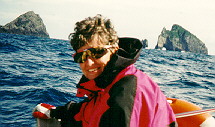 Sharon
DeVries joined our sailing trip last November in the Caribbean where
she discovered the great lifestyle aboard and the strikingly beautiful
islands and cultures. She provides a unique perspective to the trip as a
trained psychologist and on several occasions helped with diagnosing and
treating locally acquired ailments.
Sharon
DeVries joined our sailing trip last November in the Caribbean where
she discovered the great lifestyle aboard and the strikingly beautiful
islands and cultures. She provides a unique perspective to the trip as a
trained psychologist and on several occasions helped with diagnosing and
treating locally acquired ailments.
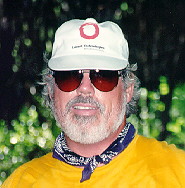 Tom
Guthrie is an avid sailor and experienced skipper specializing in sail
trim. He likes to get up late, start slow, and taper off though often is
sometimes motivated by the desire to reach our destination in time to
enjoy the afternoon sun. Tom is an excellent host who attracts people who
like to party late. Both the sailing experience and the life aboard is
always a great event for those aboard Tom's boat.
Tom
Guthrie is an avid sailor and experienced skipper specializing in sail
trim. He likes to get up late, start slow, and taper off though often is
sometimes motivated by the desire to reach our destination in time to
enjoy the afternoon sun. Tom is an excellent host who attracts people who
like to party late. Both the sailing experience and the life aboard is
always a great event for those aboard Tom's boat.
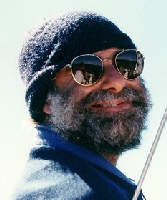 Doug
Rapkine is an excellent sailor and boat owner whose enthusiasm and
helpfulness defines the standard for other sailors. He is an expert at all
aspects of sailing, loves water sorts (especially wind surfing and scuba
diving), and is always helpful - a true pleasure to sail with. Doug is up
at sunrise swimming and does not miss any adventure opportunity. He
believes that you can sleep when you are dead and that when on vacation it
is a good idea to do everything possible.
Doug
Rapkine is an excellent sailor and boat owner whose enthusiasm and
helpfulness defines the standard for other sailors. He is an expert at all
aspects of sailing, loves water sorts (especially wind surfing and scuba
diving), and is always helpful - a true pleasure to sail with. Doug is up
at sunrise swimming and does not miss any adventure opportunity. He
believes that you can sleep when you are dead and that when on vacation it
is a good idea to do everything possible.
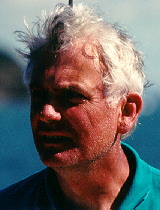 Jim
Clemens is most knowledgeable sailor and skipper-in-training. He loves
sailing the British Virgin Islands, the Greek Islands, and the South
Pacific. His plans to retire soon and spend a good part of his time aboard
a boat exploring different island groups. He started sailing during a
lessons week and found great pleasure in the life style and the exciting
destinations that we have visited.
Jim
Clemens is most knowledgeable sailor and skipper-in-training. He loves
sailing the British Virgin Islands, the Greek Islands, and the South
Pacific. His plans to retire soon and spend a good part of his time aboard
a boat exploring different island groups. He started sailing during a
lessons week and found great pleasure in the life style and the exciting
destinations that we have visited.
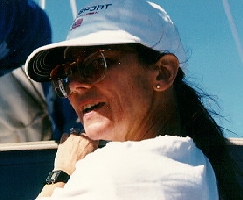 Dianna
Clemens is a laid back sailor with excellent skills and a keen
interest in all aspects of sailing. She enjoys exploring the local
cultures and villages as much as working aboard during a day of good
winds.
Dianna
Clemens is a laid back sailor with excellent skills and a keen
interest in all aspects of sailing. She enjoys exploring the local
cultures and villages as much as working aboard during a day of good
winds.
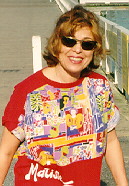 Mariam
Nigohosian is a world traveler and enjoys exploring the many islands
that we visit. She is interested in the variety of cultures and many
activities available.
Mariam
Nigohosian is a world traveler and enjoys exploring the many islands
that we visit. She is interested in the variety of cultures and many
activities available.
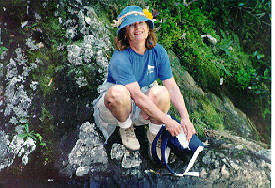 Carolanne
Van Hise joined our sailing group last November in the Caribbean where
she discovered the great life-style aboard the boats. There is always
something to do and lots of fun people to do things with.
Carolanne
Van Hise joined our sailing group last November in the Caribbean where
she discovered the great life-style aboard the boats. There is always
something to do and lots of fun people to do things with.
 Anton
Obeid ...
Anton
Obeid ...
life aboard…
Sailing... The duties aboard the boat were easy. It
took about a half hour to get ready to get under way and another ten
minutes to weigh and stow the anchor. Once we set our sails and cleaned up
the lines we would stay on one point of sail for as long as five hours. We
had some excellent music and the stereo speakers were strategically placed
in the cockpit topside. Life was very, very good.
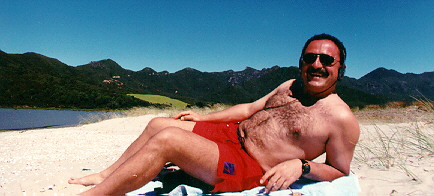 Relaxing...
Relaxing...
After Sailing... We would relax and enjoy the late
afternoon and early evening.
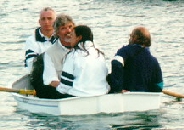 Rowing to Shore...
Rowing to Shore...
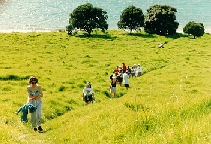 Hiking...
Hiking...
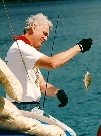 Fishing...
Fishing...
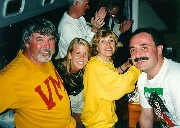 Partying...
Partying...
Joy Baths... In the late afternoon or early evening we
would bath in the ocean using sea soap or Joy. Joy dish detergent is one
of the few soaps that will lather in the ocean. The joy bathing procedure
was simple - jump in the ocean, lather up on the swim platform, back in
the ocean to rinse off, then a quick sprits with fresh water would leave
us squeaky clean just like home. The advantages are: (1) it's fun to bath
with your friends, (2) it saves fresh boat water, and (3) it's cool. The
disadvantages are: (1) you can see yourself in the reflection you're so
clean, (2) you smell like fresh lemons, and (3) your hair is light and
fluffy. Warning: Don't try this at home. It doesn't work in fresh water.
Epilog... 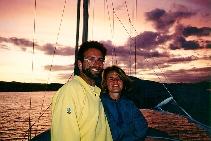
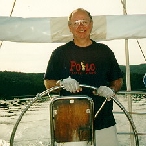
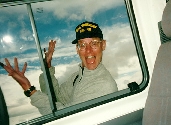 And there you
have it...
And there you
have it... 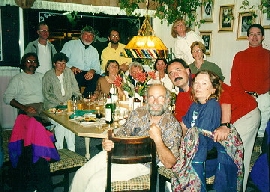
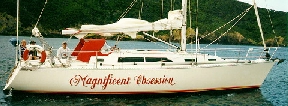
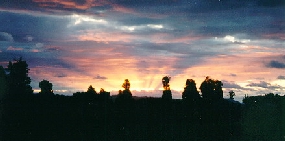
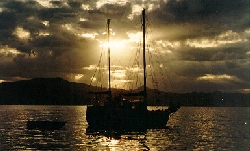
Auckland abounds with attractive shops, restaurants, and entertainment.
It is a cultural center of the South Pacific. Rotorua is a thermal
wonderland with geysers, hot springs, and mud pools; abundant wildlife and
parks; and, a traditional Maori Hangi "cooked feast" and
concert. Queenstown in the South is picturesque with lakes, mountains, and
rivers dominating the landscape awesome white water river trips. Mount
Cook includes the most spectacular Peaks of the Southern Alps with
permanent snow and glacier ice the home of the Tasman Glacier. The Milford
Track is a famous hiking route near the Fiordland National Park and Lake
Te Anau with spectacular glow-worm caves.
Recommendation: Just do it!
Passports are required and visas are not for Americans and most
other nationals.
Weather in New Zealand is warm but not hot in the summer (70's
F) and cool but not cold in the winter (50's F). The Bay of Islands is
pleasant year around compared with the southern interior and mountains. We
found that the mornings were a little cool and the afternoons were
pleasantly warm. The evenings were great for sleeping and there were few
bugs except for a few harbors.
Clothing is typical for summer with a light raincoat and a
sweater or cardigan. We found the evenings during the first half of March
to be cool making long pants and a light jacket appropriate.
Insurance is recommended for luggage and medical coverage for
the duration of the trip. Be sure that you are covered in this part of the
world. The New Zealand medical system will cover you in case of an
accident but it will not cover you for illness. Nobody had additional
insurance for our New Zealand adventure and we felt that it was an
acceptable risk.
Activities include beach combing, snorkeling, jeeping, gourmet
dining, scuba diving, wind surfing, horse back riding, shopping, all with
numerous photo opportunities. We did not go horse back riding though there
were several places that offered interesting rides. Scuba diving would
have been most excellent at Poor Knights Island but the weather did not
cooperate with us prior to arriving there so we did not have enough time.
Currency is the New Zealand dollar which is currently equal to
about 65¢ US. It is best to bring half your money in Traveler's' Checks.
In general, we brought very little US currency and were able to get local
currency from the ATM machines.
Tipping is not a New Zealand custom, so don't. They have a great
aversion to it.
Language spoken is English though some natives also speak Maori.


